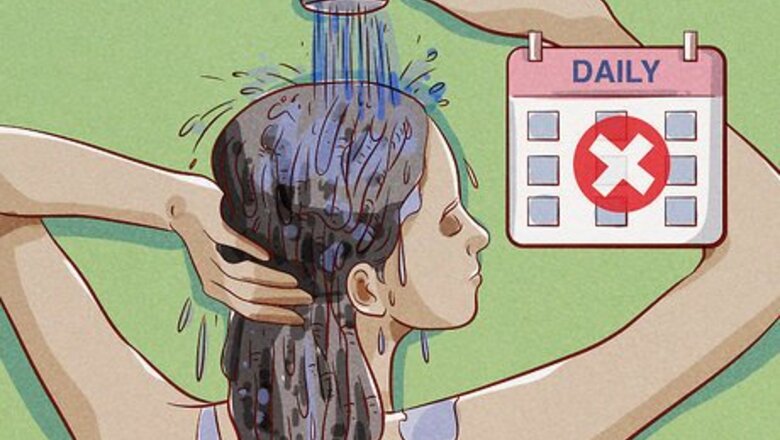
views
Shampooing Thick Hair

Wash your hair every 3 to 4 days if you have thick or curly hair. Thick hair, or hair that is super curly, will get overly-dry really quickly if you wash it every day because it will get stripped of its essential, natural oils. Spreading out your washes will help keep your thick hair healthier for longer. There are so many different kinds of hair types out there! If you have thick hair, chances are you can’t see much of your scalp when your hair is parted. Similarly, if your hair holds an “S” or “Z” shape when it’s in its natural state, you most likely have thick hair.Tip: Try using dry shampoo on the in-between days to absorb excess oil.

Wait 7 to 10 days between each wash if you have natural black hair. Natural hair is also called “Afro-textured” hair and it can encompass many different types of African hair. Generally, it refers to hair that hasn’t been altered by chemical processing or extreme heat styling. Washing natural hair too often will remove moisture from your locks. If you’re looking at styling and product guides, chances are you are a 3 (curly) or 4 (kinky) on the hair-type scale. Remember, you know your hair best! It may be that your hair needs to be washed twice a week, or maybe you can go 2 to 3 weeks between washes.
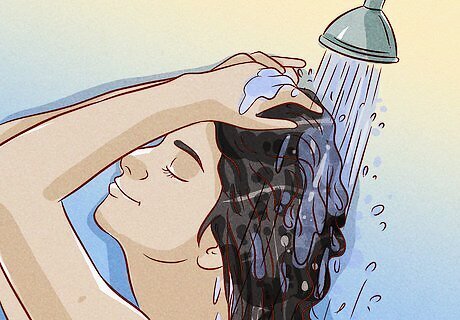
Use an oil treatment before you wash your locks if you have natural hair. Separate your hair into 4 to 6 sections with your fingers. Put about 1 tablespoon (15 mL) of coconut oil, olive oil, or avocado oil onto each section of hair. Put a plastic cap over your hair and set a timer for 1 hour. Once the treatment is done, use your fingers (instead of a brush or comb) to detangle your hair before you get into the shower. You could even leave the oil treatment in for 2 to 3 hours depending on how much time you have available.
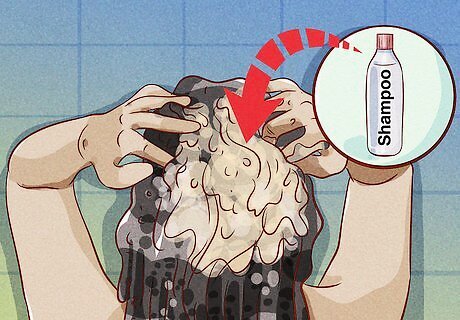
Saturate your hair with lukewarm water before applying shampoo. When you first get into the shower, let lukewarm water run through your locks for 3 to 5 minutes. Because your hair is thicker, it’ll take longer for all of it to get wet. The warm water will loosen built-up grime, product, and grease. Avoid using hot water, as it could actually damage your hair and dry it out. At this stage, you don’t need to worry about running your fingers through your hair. Just let the water do its work.

Use non-foaming, natural shampoo if you have natural hair. The texture of natural hair is really sensitive and can become brittle and coarse if you use harsh products. These non-foaming products are actually “shampoo free” and will be much gentler on your natural hair. It may take a while to get used to the lack of suds, but your hair will be healthier in the long run. Ingredients to avoid: petroleum, petrolatum, sodium lauryl sulfate, ammonium laureth sulfate, and ammonium lauryl sulfate.

Pick a shampoo for your specific texture if you have thick or curly hair. Maybe your hair tends to be frizzy or dry, or maybe you have a dry scalp, which can lead to dandruff. Or, if you have curly hair, maybe you want a product that will help enhance those natural curls. Focus on sulfate-free shampoos (sulfates will dry out your hair), and look for moisturizing qualities when picking your next product. In general, look for shampoos that contain coconut oil or argan oil. These products will help cleanse your hair without over-drying your locks. Hazel seed, raspberry oil, ojon oil, grapefruit extracts, olive oil, and Moroccan oil are other great ingredients to look for.

Spend 3 to 5 minutes massaging shampoo into your hair. With your thick hair, you’ll need to use more shampoo than what’s recommended on the bottle. Put the shampoo onto your palms and wet it with water to work it into a lather. Start massaging the shampoo into your roots and work your way down to the tips. Be as gentle as possible while lathering your locks. Don’t rip through tangles with your fingers; instead, try to work around them and focus on cleansing your scalp.

Wash your hair a second time if you wash less than twice a week. If you go more than 3 days between washes, there will be more build-up in your hair and washing it twice will ensure that all of that grime gets washed away. Repeat the shampooing and massaging process for another 3 minutes. If you get bored in the shower, try listening to music or a podcast. You can enjoy some entertainment while giving your hair the care it deserves!
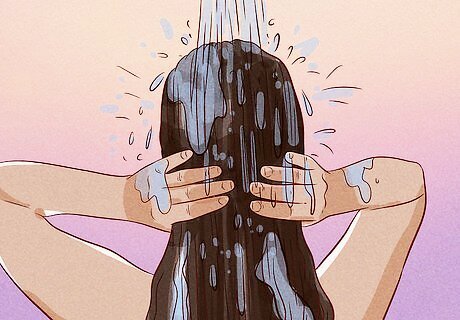
Rinse the shampoo completely out of your hair. Let lukewarm water run through your hair and use your fingers to gently aid the rinsing process. Don’t worry too much if you come across knots and tangles—the conditioning process will take care of those later. Just focus on getting all the suds out of your hair. For really thick, long hair, it can help to flip your hair upside-down to access the underside and make sure all the shampoo is rinsed away.
Conditioning, Combing, and Drying
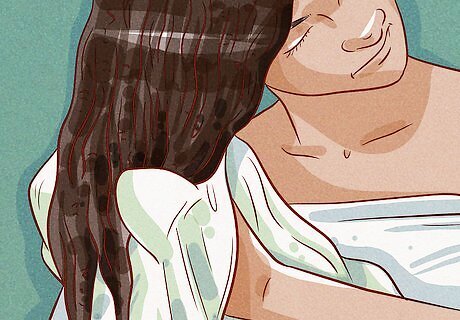
Apply conditioner to your hair and let it sit for 5 to 10 minutes. Opt for a deep-hydrating conditioner to keep your locks moisturized and frizz-free. Use about twice the amount of conditioner as you did shampoo, though if your hair is exceptionally long or thick, you may need an entire palm-full of conditioner. Apply it mainly to the tips of your hair up through the middle sections.Tip: Use minimal conditioner on your roots to prevent build-up from accumulating quickly.
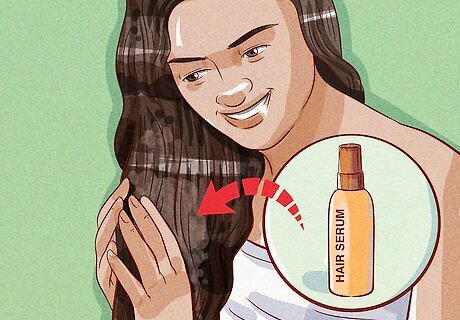
Apply heat to your hair before you rinse it out if you have natural hair. Natural hair needs a little extra TLC to help it absorb all the moisturizing goodness from the conditioner. After you apply the conditioner to your hair, cover your hair with a shower cap or something similar. Then, wrap a damp, warm towel around the shower cap and let the conditioner sit for 20 to 30 minutes. During the 20 to 30 minutes, you can definitely get out of the shower and do something else, or, if you have a tub, you could take a relaxing soak while you wait for your conditioner to do its work.
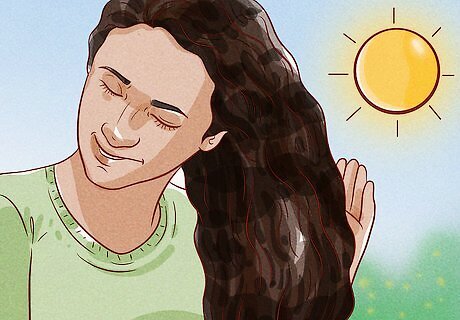
Comb your hair while the conditioner is still in it to get rid of tangles. After the appropriate amount of time has passed, use a wide-toothed comb to work out any tangles. Start at the ends of your hair and move upwards towards your roots to be as gentle as possible with your hair. Avoid yanking the comb to get it through tangles; this could damage your hair and cause breakage. You can do this while you’re still in the shower, or, if you got out while your hair was being conditioned, you could also do it out of the shower.
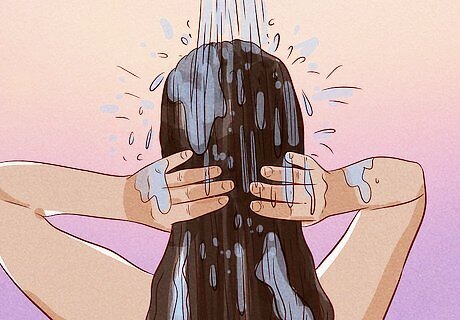
Rinse out the conditioner with cold water. Lower the water temperature and let the water run through your hair to remove the conditioner. Avoid scrubbing or squeezing your hair, as this could actually remove the protective coating that the conditioner provides. Just gently run your fingers through your hair to make sure you rinse away any clumps of conditioner. The cold water helps to lock in moisture. Depending on how thick your hair is, it could take 3 to 5 minutes to fully rinse out the conditioner.
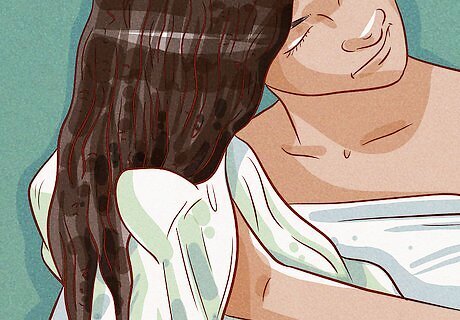
Pat your hair dry with a towel rather than rubbing it. Avoid using a rough back-and-forth motion on your hair when you’re drying it. Instead, pat it in sections with a soft towel or even a cotton T-shirt. Microfiber towels are great for thick, natural, or curly hair, as they create less friction.

Apply a leave-in conditioner or serum to moisturize your hair. Look for products made specifically for thick or natural hair so that you can hydrate your locks without weighing them down. When applying the product, focus on the tips of your hair through the middle sections and avoid applying too much product to your roots. Products with shea butter work really well with natural hair.
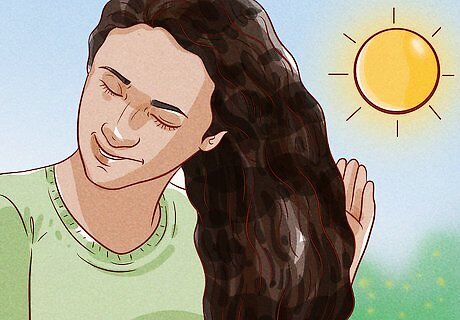
Let your hair air dry the rest of the way to avoid damaging it with heat. When you can, it’s best to let your hair dry naturally on its own instead of using a blow dryer or other heat-styling tools. Because you have thick hair, it may be best to do your washing at night so that your hair can dry while you’re sleeping. At the least, try to let your hair air dry at least 75% of the way. This will greatly reduce the amount of time you’ll need to blow-dry it, which will minimize damage. If you do decide to blow-dry your hair, use a low-heat setting.




















Comments
0 comment